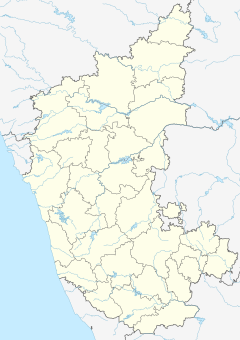
Back হৈসলেশ্বর মন্দির Bengali/Bangla Temple de Hoysaleśvara French מקדש הויסלשוורה HE होयसलेश्वर मंदिर Hindi ಹೊಯ್ಸಳೇಶ್ವರ ದೇವಸ್ಥಾನ Kannada होयसळेश्वर मंदिर Marathi Tempelj Hojsalešvara Slovenian ஹோய்சாலேஸ்வரர் கோவில் Tamil โหยสเฬศวรเทวสถาน Thai Hoysaleşvara Tapınağı Turkish
| Hoysaleswara Temple | |
|---|---|
ಹೊಯ್ಸಳೇಶ್ವರ ದೇವಸ್ಥಾನ | |
 Hoysaleswara temple at Halebidu | |
| Religion | |
| Affiliation | Hinduism |
| District | Hassan |
| Deity | Shiva |
| Location | |
| Location | Halebidu |
| State | Karnataka |
| Country | India |
| Geographic coordinates | 13°12′47.5″N 75°59′42.0″E / 13.213194°N 75.995000°E |
| Architecture | |
| Type | Hoysala |
| Creator | Ketamalla, Hoysala Vishnuvardhana |
| Completed | 12th-century |
| Official name | Sacred Ensembles of the Hoysalas |
| Type | Cultural |
| Criteria | i, ii, iv |
| Designated | 2023 (45th session) |
| Reference no. | 1670[1] |
Hoysaleswara temple, also referred simply as the Halebidu temple, is a 12th-century Hindu temple dedicated to the god Shiva. It is the largest monument in Halebidu, a town in the state of Karnataka, India and the former capital of the Hoysala Empire. The temple was built on the banks of a large man-made lake, and sponsored by King Vishnuvardhana of the Hoysala Empire.[2] Its construction started around 1121 CE and was complete in 1160 CE.[3][4]
During the early 14th century, Halebidu was twice sacked and plundered by the Muslim armies of the Delhi Sultanate from northern India,[5][6][7] and the temple and the capital fell into a state of ruin and neglect.[8] It is 30 kilometres (19 mi) from Hassan city and about 210 kilometres (130 mi) from Bengaluru.[9]
The Hoysaleswara temple is a Shaivism tradition monument, yet reverentially includes many themes from Vaishnavism and Shaktism tradition of Hinduism, as well as images from Jainism.[10]
The Hoysaleswara temple is a twin-temple dedicated to Hoysaleswara and Santaleswara Shiva lingas, named after the masculine and feminine aspects, both equal and joined at their transept. It has two Nandi shrines outside, where each seated Nandi face the respective Shiva linga inside.[11] The temple includes a smaller sanctum for the Hindu Sun god Surya. It once had superstructure towers, but no longer and the temple looks flat.[12] The temple faces east, though the monument is presently visited from the north side. Both the main temples and the Nandi shrines are based on a square plan.[13] The temple was carved from soapstone.
It is notable for its sculptures, intricate reliefs, detailed friezes as well its history, iconography, inscriptions in North Indian and South Indian scripts. The temple artwork provides a pictorial window into the life and culture in the 12th century South India. About 340 large reliefs depict the Hindu theology and associated legends.[10] Numerous smaller friezes narrate Hindu texts such as the Ramayana, the Mahabharata and the Bhagavata Purana. Some friezes below large reliefs portray its narrative episodes.[2][11][14]
The artwork in Hoysaleswara temple is damaged but largely intact. Within a few kilometers of the temple are numerous ruins of Hoysala architecture, including the Jain Basadi complex and the Kedareshwara temple.
The Hoysaleswara Temple, along with the nearby Chennakeshava Temple at Belur and the Keshava Temple at Somanathapura was declared a World Heritage Site by UNESCO in 2023 as part of the Sacred Ensembles of the Hoysalas.[2]
- ^ "Sacred Ensembles of the Hoysalas". UNESCO World Heritage Centre. Retrieved 24 September 2023.
- ^ a b c Permanent Delegation of India to UNESCO (2014), Sacred Ensembles of the Hoysala, UNESCO
- ^ Kirsti Evans 1997, p. 8.
- ^ Foekema (1996), p.59
- ^ Robert Bradnock; Roma Bradnock (2000). India Handbook. McGraw-Hill. p. 959. ISBN 978-0-658-01151-1.
- ^ Catherine B. Asher (1995). India 2001: Reference Encyclopedia. South Asia. pp. 29–30. ISBN 978-0-945921-42-4.
- ^ Joan-Pau Rubiés (2002). Travel and Ethnology in the Renaissance: South India Through European Eyes, 1250-1625. Cambridge University Press. pp. 13–15. ISBN 978-0-521-52613-5.
- ^ Kamath (2001), p129
- ^ Cite error: The named reference
Subramanianwas invoked but never defined (see the help page). - ^ a b Kirsti Evans 1997, pp. 196–199.
- ^ a b Krishna 1971, pp. 33–34, 37–46.
- ^ Krishna 1971, pp. 34–36.
- ^ Gerard Foekema 1996, pp. 59–61.
- ^ Kirsti Evans 1997, pp. 8–10, 196–199.

